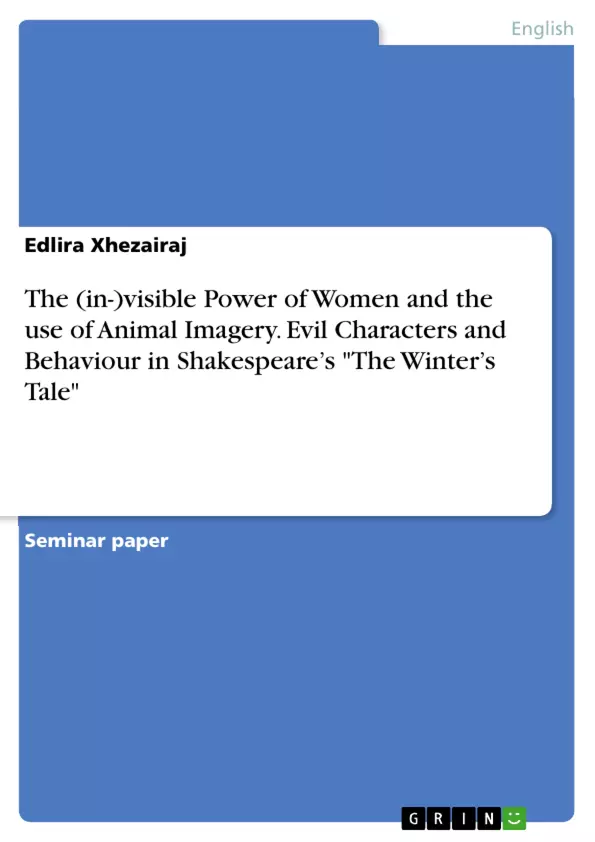The primary concern of this paper is to analyse the social structure in Shakespeare`s "The Winter`s Tale" based on values of honesty and loyalty, through two different approaches: The influential capability of women in the play and the animal imagery, used to show depreciation or devaluation of infidel behaviour. This analysis is based on the Arden edition of The Winter’s Tale (2010), a modern critical edition, whose detailed notes and commentary guide us to a deeper understanding of Shakespeare’s work.
To achieve this goal, the paper is organized into three main sections, with each of them consisting of sub-sections. In the first section, some information about how women are represented in Shakespeare’s Winter’s Tale, the perception of their role and appearance in the social structure in the play is provided. In the second section, the main issues of gender inequality will be discussed with special attention paid to the principles of Primogeniture and Patrilineage and how they affect the position of women.
Moreover, the same section focuses on qualities of honesty and fidelity, which seem to be the fundamental parts of the society in Shakespeare’s play. In contrast to that, the last section, provides examples of figurative language, like animal imagery and discusses how they shape the image of dishonest and unfaithful women. In the conclusion, the most important perspectives discussed in this paper will be demonstrated, and research questions will be offered that could be answered in other research papers in the future.
The first impression one has while reading Shakespeare’s play The Winter’s Tale is that adult male characters are almost omnipotent. The jealous King Leontes interprets falsely the actions of his wife and convinced of being right, no matter what she claims, he orders her imprisonment. Two lords at court and king’s attendants are also shown to take their fate into their own hands. Firstly, Leontes loyal retainer, Camillo - who has been ordered to poison the Bohemian king - decides to warn Polixenes, and the two men flee Sicilia immediately. Secondly, lord Antigonus has been ordered to take Hermione’s child and abandon it in some desolate place. Rather than do so, he decides to follow the directions of a dream and leaves the infant with gold and other objects on a beach in Bohemia.
Table of Contents
- Introduction
- Feminine nature in the Winter's Tale
- Hermione
- Paulina
- Perdita
- Gender issues in the play: Patriarchy, patrilineage, and the position of women.
- Women sexuality and honesty
- Animal imagery and other literary devices to describe evil behaviour.
- Conclusion
Objectives and Key Themes
This seminar paper explores the portrayal of women and the use of animal imagery in Shakespeare's The Winter's Tale, aiming to understand how these elements contribute to the play's themes of power, deception, and redemption. The paper focuses on the social structure of the play, particularly the roles and influence of women within a patriarchal society. It also analyzes the use of animal imagery to depict dishonest and unfaithful behavior.
- The portrayal of women in The Winter's Tale and their influence within the patriarchal society of the play.
- The impact of historical context, particularly the Jacobean Era and witch-hunting practices, on the representation of women in Shakespeare's work.
- The use of animal imagery to represent and criticize dishonest and unfaithful behavior.
- The intersection of gender, power dynamics, and social structures within the play.
- The exploration of themes like honesty, loyalty, and redemption within the context of the play's narrative.
Chapter Summaries
The introduction establishes the context of the play and its central themes, highlighting the initial impression of male dominance and the apparent powerlessness of female characters. The paper focuses on analyzing the capabilities of women and the use of animal imagery to describe their behavior.
The first chapter examines the portrayal of three key female characters: Hermione, Paulina, and Perdita. It explores their roles in the play, their interactions with male characters, and their perceived influence within the social structure. The chapter also analyzes how their activities and qualities contribute to the overall theme of women's resilience and agency.
The second chapter delves into the gender issues prevalent in The Winter's Tale, discussing the implications of patriarchy, patrilineage, and the position of women within the play's society. It explores the themes of honesty and fidelity and their significance within the play's narrative. The chapter examines how these themes shape the relationships and interactions between male and female characters.
The third chapter focuses on the use of animal imagery and other literary devices in the play to describe dishonest and unfaithful behavior, particularly as they relate to women. It explores the power of language and symbolism in shaping the perception of female characters and their actions. The chapter analyzes how these devices contribute to the play's themes of deception, redemption, and the complexities of human nature.
Keywords
The Winter's Tale, Shakespeare, feminine power, animal imagery, patriarchy, patrilineage, honesty, loyalty, gender inequality, deception, redemption, Jacobean Era, witch-hunting, social structure, literary devices, figurative language.
- Citar trabajo
- Edlira Xhezairaj (Autor), 2022, The (in-)visible Power of Women and the use of Animal Imagery. Evil Characters and Behaviour in Shakespeare’s "The Winter’s Tale", Múnich, GRIN Verlag, https://www.grin.com/document/1394942



